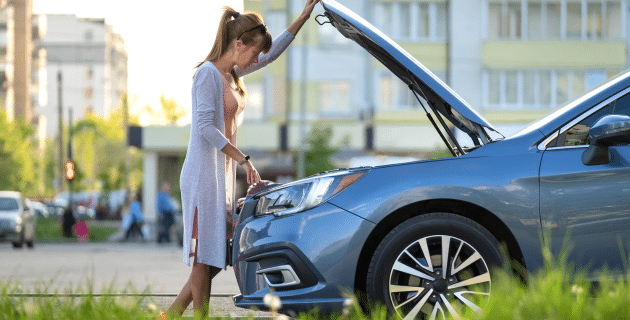You’re driving along and, suddenly, you notice a puff of smoke. The needle on your dashboard starts inching into the red. There goes your engine warning light. Your car is overheating.
Don’t panic. While overheating can cause permanent damage to your car, your quick action can make a difference. Here’s a guide on why engines overheat, steps to take to prevent it, and what to do if your vehicle overheats this summer.
Why do engines overheat?
An engine naturally generates heat when it runs. The cooling system helps it from getting too hot. Sometimes, however, the system fails. Here are some common reasons an engine overheats.
- Low oil or coolant levels
- Leak or blockage in the cooling system
- Faulty thermostat
- Clogged or worn-out hoses or belts
- Defective water pump
- Radiator failure, damaged radiator cap
- Damaged or blown head gaskets, warped cylinder heads
Watch for these signs.
You may not even be aware your engine is getting too hot until it’s too late. That’s why it is important to look for the signs of overheating.
Early signs
- Ticking noises in your engine that could be related to a loss of lubrication
- Thumping noises from cold coolant mixing with boiling coolant (due to a failed sensor in your thermostat)
- An engine that gets hot after short trips
- A puddle of coolant on the ground after you’ve parked
Emergency signs
- Steam (that looks like smoke) coming from the vehicle’s hood
- Spike in your temperature gauge or check engine warning light
- Strange smells or odors from the front of your car (Oil produces a burnt smell, coolant smells sweet, and you may also notice the smells of hot metal or burning rubber.)
- Reduced engine power
What to do if your car overheats…
Overheating can lead to serious and expensive damage if it’s not addressed quickly. Follow these steps if your car overheats.
- Turn on the heater.
It may seem counterintuitive but turning on the heat will draw heat away from your engine. Sometimes that’s enough to move the gauge back into the safe area. Importantly, do not run your air conditioning. That will only make the car heat up more.
- Stay calm and pull over safely.
Put on your hazard lights and make your way to the side of the road. If you’re on a highway or busy street, do so as soon and safely as possible. Pull over in a place where you can wait it out for a while, and where emergency service vehicles can easily access your vehicle.
- Shut off the engine and wait.
It will take at least 15 to 30 minutes for the engine to cool down. There is nothing you can do at this time. Call for assistance if you think you will need it. Importantly, do not try to open the hood. Your car is dangerously hot, and you could be sprayed with boiling water or steam.
- Check the pressure of the radiator hose.
Wait until the hood is cool to the touch to open it. Then put on gloves and grab a towel. Locate the radiator hose in the upper side of your engine. Use the towel to squeeze it. If it’s stiff, there’s pressure in the system. Do not remove the radiator cap until the pressure has decreased.
- Add coolant.
Locate the radiator cap (see owner’s manual). Cover the cap with a towel and slowly push down to loosen it a quarter of a turn. That will release some of the pressure. Then fully open the cap. Refill the coolant if needed. Also add coolant to the small clear plastic overflow reservoir on the side of the radiator. Replace the cap.
- Turn on the engine.
If the gauge is normal or the warning light is off, proceed with caution. Adding coolant doesn’t fix the problem. It just allows you to get somewhere safely to address it. Note that if your car is overheating because of a hose or radiator issue, then coolant will not work.
- Drive or get towed to a service station.
If your car has overheated, it needs to be seen by a mechanic. Don’t ignore it. It may be inconvenient to get it fixed, but driving an overheated car will ruin your engine.
Prevent your car from overheating.
Overheating is common in the hot summer weather. There are steps to take to safeguard your car if it is at risk.
- Check and maintain your fluid levels. This includes coolant and oil.
- Get a coolant flush. This will remove old coolant and chemical buildups.
- Perform routine car maintenance. Do regular radiator checkups.
- Check under your vehicle for signs of coolant or oil leaks. Get them addressed right away.
- Avoid traveling in extreme heat.
Your car is one of your greatest investments. Keep it fully insured for added peace of mind. Safe travels.
This article is furnished by California Casualty, providing auto and home insurance to educators, law enforcement officers, firefighters, and nurses. Get a quote at 1.866.704.8614 or www.calcas.com.
- California Casualty Earns Financial Stability Rating® of A, Exceptional, From Demotech, Inc. - April 28, 2025
- Music & Arts Grant Recipients – 2024 - December 13, 2024
- Understanding Auto and Home Insurance Rate Changes - December 3, 2024

